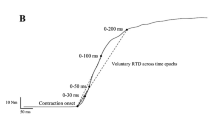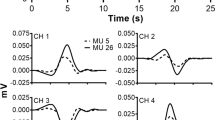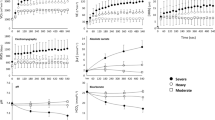Abstract
This study investigated the recruitment of type I, IIA and IIAX fibres after seven isometric contractions at 40, 70 and 100% maximal voluntary knee extension torque (MVC, 1 s on/1 s off). Biopsies of the vastus lateralis muscle were collected from seven subjects at rest and immediately post-exercise. Fibre fragments were dissected from the freeze-dried samples and characterized as type I, IIA and IIAX using mATPase staining. Phosphocreatine (PCr) and creatine (Cr) content were measured in the remaining part of characterized fibres. A decline in the ratio of PCr to Cr (PCr/Cr) was used as an indication of activation. The mean peak torques were, respectively, 39 (2), 72 (2) and 87 (6)% MVC. Cumulative distributions of type I and IIA fibres were significantly shifted to lower PCr/Cr ratios at all intensities (Kolmogorov-Smirnov test, P<0.05). The cumulative distribution of type IIAX fibres showed a significant leftward shift only at 87% MVC (P<0.05). A hierarchical order of fibre activation with increasing intensity of exercise was found, with some indication of rate coding for type I and IIA fibres. Evidence for activation of type IIAX fibres was only found at 87% MVC.


Similar content being viewed by others
References
Andersen P, Sjøgaard G (1976) Selective glycogen depletion in the subgroups of type II muscle fibres during intense submaximal exercise in man. Acta Physiol Scand 96:26A–27A
Becker R, Awiszus F (2001) Physiological alterations of maximal voluntary quadriceps activation by changes of knee joint angle. Muscle Nerve 24:667–672
Beltman JGM, Sargeant AJ, Haan H, van Mechelen W, de Haan A (2004) Changes in PCr/Cr ratio in single characterized muscle fibre fragments after only a few maximal voluntary contractions in humans. Acta Physiol Scand 180:187–193
Brooke MH, Kaiser KK (1970) Muscle fiber types: how many and what kind? Arch Neurol 23:369–379
Desmedt JE, Godaux E (1977) Ballistic contractions in man: characteristic recruitment pattern of single motor units of the tibialis anterior muscle. J Physiol (Lond) 264:673–693
Donofrio J, Coleman MS, Hutton JJ, Daoud A, Lampkin B, Dyminski J (1978) Overproduction of adenine deoxynucleosides and deoxynucletides in adenosine deaminase deficiency with severe combined immunodeficiency disease. J Clin Invest 62:884–887
Essen B, Jansson E, Henriksson J, Taylor AW, Saltin B (1975) Metabolic characteristics of fibre types in human skeletal muscle. Acta Physiol Scand 95:153–165
Freund HJ, Büdingen HJ, Dietz V (1974) Activity of single motor units from human forearm muscles during voluntary isometric contractions. J Neurophysiol 38:933–946
Gollnick PD, Armstrong RB, Saubert CW IVth, Sembrowich WL, Shepherd RE, Saltin B (1973) Glycogen depletion patterns in human skeletal muscle fibers during prolonged work. Pflügers Arch 344:1–12
Gollnick PD, Piehl K, Saltin B (1974a) Selective glycogen depletion pattern in human muscle fibres after exercise of varying intensity and at varying pedalling rates. J Physiol (Lond) 241:45–57
Gollnick PD, Karlsson J, Piehl K, Saltin B (1974b) Selective glycogen depletion in skeletal muscle fibres of man following sustained contractions. J Physiol (Lond) 241:59–67
Henneman E, Somjen G, Carpenter DO (1965) Functional significance of cell size in spinal motorneurons. J Neurophysiol 28:560–280
Henneman E, Clamann HP, Gillies JD, Skinner RD (1974) Rank order of motoneurons within a pool: law of combination. J Neurophysiol 37:1338–1349
Infante AA, Klaupiks D, Davies RE (1965) Phosphorylcreatine consumption during single working contractions of isolated muscle. Biochim Biophys Acta 94:504–515
Karatzaferi C, de Haan A, Offringa C, Sargeant AJ (1999) Improved high-performance liquid chromatographic assay for the determination of “high-energy” phosphates in mammalian skeletal muscle: application to a single-fibre study in man. J Chromatogr B Biomed Sci Appl 730:183–191
Karatzaferi C, de Haan A, van Mechelen W, Sargeant AJ (2001) Metabolic changes in single human fibres during brief maximal exercise. Exp Physiol 86:411–415
Kernell D, Lind A, van Diemen ABJP, de Haan A (1995) Relative degree of stimulation-evoked glycogen degradation in muscle fibers of different type in rat gastrocnemius. J Physiol (Lond) 484:139–153
Luca CJ de, LeFever RS, McCue MP, Xenakis AP (1982) Behavior of human motor units in different muscles during linearly varying contractions. J Physiol (Lond) 329:113–128
Milner-Brown HS, Stein RB, Yemm R (1973) The orderly recruitment of human motor units during voluntary isometric contractions. J Physiol (Lond) 230:359–370
Person RS, Kudina LP (1972) Discharge frequency and discharge pattern of human motor units during voluntary contraction of muscle. Electroencephalogr Clin Neurophysiol 32:471–483
Sahlin K, Harris RC, Hultman E (1979) Resynthesis of creatine phosphate in human muscle after exercise in relation to intramuscular pH and availability of oxygen. Scand J Clin Lab Invest 39:551–558
Sant’Ana Pereira JAA, Wessels A, Nijtmans L, Moorman AFM, Sargeant AJ (1995) New method for the accurate characterization of single human skeletal muscle fibres demonstrates a relation between mATPase and MyHC expression in pure and hybrid fibre types. J Muscle Res Cell Motil 16:21–34
Sant’Ana Pereira JAA, Sargeant AJ, Rademaker ACHJ, de Haan A, van Mechelen W (1996) Myosin heavy chain isoform expression and high energy phosphate content in human muscle fibres at rest and post-exercise. J Physiol (Lond) 496:583–588
Sargeant AJ, Jones DA (1995) The significance of motor unit variability in sustaining mechanical output of muscle. Adv Exp Med Biol 384:323–338
Siegel S (1956) Nonparametric statistics for the behavioral sciences. McGraw-Hill Kogakusha, Tokyo
Suter E, Herzog W (1997) Extent of muscle inhibition as a function of knee angle. J Electromyogr Kinesiol 7:123–130
Vøllestad NK, Blom PCS (1985) Effect of varying exercise intensity on glycogen depletion in human muscle fibres. Acta Physiol Scand 125:395–405
Vøllestad NK, Vaage O, Hermansen L (1984) Muscle glycogen depletion patterns in type I and subgroups of type II fibres during prolonged severe exercise in man. Acta Physiol Scand 122:433–441
Westra HG, de Haan A, van Doorn JE, de Haan EJ (1988) Anaerobic chemical changes and mechanical output during isometric tetani of rat skeletal muscle in situ. Pflügers Arch 412:121–127
Acknowledgements
The authors wish to thank C. Offringa and M.R. van der Vliet for expert technical assistance. In addition, we gratefully acknowledge the financial support from the Haak Bastiaanse-Kuneman Stichting.
Author information
Authors and Affiliations
Corresponding author
Rights and permissions
About this article
Cite this article
Beltman, J.G.M., de Haan, A., Haan, H. et al. Metabolically assessed muscle fibre recruitment in brief isometric contractions at different intensities. Eur J Appl Physiol 92, 485–492 (2004). https://doi.org/10.1007/s00421-004-1105-6
Accepted:
Published:
Issue Date:
DOI: https://doi.org/10.1007/s00421-004-1105-6




